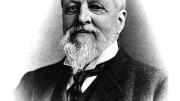Born roughly a year apart on opposite sides of the Pacific Rim--one in Woodside, California, near Palo Alto, and one in Shanghai--Samantha Rosekrans ’11 and Holly Cao ’12 developed as tennis players in parallel ways. They now co-captain the Harvard women’s varsity and have enjoyed considerable success as a doubles team in the past two years, though they partner with other teammates as well. The pair reached the round of 16 at the Intercollegiate Tennis Association’s (ITA) Northeast Regional tournament last fall, and in its preseason poll, the ITA ranked them at number 40 nationally. Currently, Cao plays in the top singles position for the Crimson, while Rosekrans competes in the fourth slot.
Both are tall: Rosekrans stands 5 feet, 11 inches; Cao is 5 feet, 9½. Their games complement each other in doubles. “Normally, I just hit hard from the back, and Sam finishes at the net,” says Cao, who owns a ferocious two-handed backhand. “She has great volleys.” Rosekrans confirms that strategy: “Holly excels at her groundstrokes, and I prefer taking charge at the net. When we’re in a groove, I’m able to be intuitive and read where she’ll hit it--we can be very much in sync. I can sense when she lobs.”
Rosekrans’s mother, Pam, actually played tennis on the very day Samantha was born (prior to delivery, to be sure). Both her parents were rated in their younger years at 5.0 on the United States Tennis Association’s official scale, placing them among the elite of club tennis players. Peter Rosekrans, a landscape architect, first put a racquet in his daughter’s hand when she was five years old. By age seven, she had found Jeff Arons, the tennis coach who has been with her ever since.
Cao (pronounced “cow”) first touched a racquet at age six, the day after she first set foot in Australia. (She was joining her parents, Charlie Cao and Sylvia Yang, who had emigrated seeking a better life, leaving her for three years with her grandparents.) Cao, too, has had a one-coach career, mentored entirely by her father. Both her parents were university lecturers in China, and her father played on the university volleyball team. He wanted his only child to become a professional athlete.
For a while, Cao seemed headed that way. She played her first tournament at seven, only nine months after hitting her first ball. Before long, she made the quarterfinals of a state tournament in New South Wales, where the family lived, and “Dad said, ‘Next year, you’re going to win this tournament.’” She did. She also won a national 12-and-under event at Melbourne Park, site of the Australian Open, and played in junior events at the Open itself. By 2006 she had become the top-ranked junior girl in the country, and even had a professional ranking of 699 after playing a few events on the Women’s Tennis Association schedule. “Up until I was 15, my goal was to go pro,” Cao says. “So college didn’t even enter my mind.” (In Australia, as elsewhere outside the United States, intercollegiate athletics do not exist.)
Around age 15 or 16, however, having played a few international junior tournaments, “I realized that I was not good enough. I wasn’t up to scratch,” Cao says. “And also, I didn’t love tennis as much as I should to pursue it at a pro level. I was keeping up with my studies and doing well at school. I decided that furthering my education and playing tennis at the same time would be the best option for me.” Australian player Melissa Anderson ’06 (see “Down-Under Dominator,” July-August 2006, page 72) mentioned playing for the Crimson, and Cao contacted then-Harvard women’s coach Gordon Graham. Before long, she was unpacking her bags in the Yard.
Meanwhile, Rosekrans was prospering in American junior tournaments, reaching the finals of the national “Little Mo” tournament of the Maureen Connolly Brinker Tennis Foundation each year from ages eight to 11. As a teen, traveling to tournaments on weekends meant, of course, “a big sacrifice in your social life,” she says. Still, she became one of the top juniors in northern California, and at 16 was among the nation’s top 20. She was friendly with former Harvard varsity player Stephanie Schnitter ’08, and “knew I wanted to end up here,” she says.
She did, and it has worked out. As co-captains, Rosekrans and Cao feel they can lead this squad to an Ivy championship, something the Crimson last tasted two years ago when they shared the title with Princeton. The pair get on well both on and off the court, on occasion getting to a movie or a play together. In tennis style, Cao hits the ball flat, whereas Rosekrans favors a topspin forehand, but when you grow up on separate continents--well, there are bound to be some differences.









